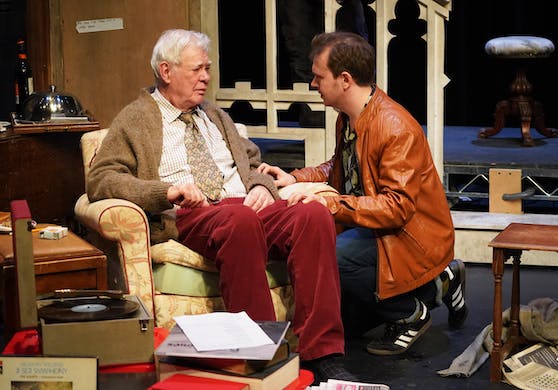Looking Over the Shoulders of Giants
Alan Bennett’s 2009 play-within-a-play ‘The Habit of Art’ is a layered examination of the creative process and of grappling with the complicated legacies of titans.

“I want to hear about the shortcomings of great men, their fears and their failings.” In a way, this prescient first line is all you need to know about “The Habit of Art,” Alan Bennett’s 2009 play-within-a-play: a layered examination of the creative process and of grappling with the complicated legacies of titans.
“I’ve had enough of their vision, how they altered the landscape,” the player continues. The audience peers into a rehearsal room where actors are hobbling through a run of the fictional play “Caliban’s Day,” inspired by W.H. Auden’s didactic reworking of “The Tempest” called “The Sea and the Mirror,” a series of poems, ironically, meant to restore voice to the voiceless. “We stand on their shoulders to survey our lives.”
The stage is set to resemble Auden’s Christ Church home in 1972, where a series of imagined encounters occur. One of the actors, named Fitz, plays Auden. The poet is first interviewed by biographer Humphrey Carpenter (an interaction you can read about), famous in his own right for his capturing the life of J.R.R. Tolkien. They are interrupted by Stuart, a young sex worker that Auden calls his “rent boy”.
In the play’s second and more engaging half, Auden is sought out by a long-lost friend, composer Benjamin Britten, for advice on his opera adaptation of Thomas Mann’s “Death in Venice.” Although we know no such conversation ever occurred, the device is a brilliant way to bring the foils face to face in their twilight years. The contrast is stark — Britten is reluctant to discuss his well-documented attraction to young boys, while Auden is troublingly confident in his sexuality.
A great Wall Street Journal theater critic, Terry Teachout, followed the progression of “The Habit of Art” from its opening in 2009 at London’s National Theatre to Washington’s Studio Theatre in 2011. “I assumed that someone in New York would get around to staging it sooner or later,” he wrote in his review of the streamed pandemic-era performance by Original Theatre and 59E59 Theaters. Teachout died before he could see it come to life on a city stage.
As an ardent Teachout reader and fan, I was honored to see this show in person with much of the original cast and creative team still intact.
It didn’t disappoint. Mr. Bennett’s script is equal parts quaint and challenging, if slightly too long. The actors wrestle aloud with their characters. Fitz, embodied by West End standout Matthew Kelly, is unable to stomach Auden’s crassness and halts the piece to confront an uncomfortable reality: These creative giants were pedophiles, and left an ocean of voiceless victims in their wake. His discomfort mirrors our own. In this way, Mr. Bennett works his usual magic, anticipating our protestations before we can express them.
His clever rehearsal-room framing device allows the audience an intimate view of the other side of the curtain, where the actors grapple with the same questions we do. How are these men capable of both beauty and profound ugliness? How do we contend with evil without erasing history? How do we tell this story well?
Ultimately, “The Habit of Art” underscores the importance of the creative process, one that cultivates within us the ability to discern, to wrestle. To recognize beauty and to savor it. To understand grace and when to bestow and withhold it. To hold conflicting truths in the same hand.
Isn’t that what art is for?

